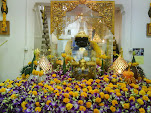 The current era, which is known as the Rattanakosin period began when King Rama I established Bangkok as the capital of Thailand in the 10th century. The period can be categorized into 2 distinct phases.
The current era, which is known as the Rattanakosin period began when King Rama I established Bangkok as the capital of Thailand in the 10th century. The period can be categorized into 2 distinct phases. - Phase 1 : In the early Rattanakosin period ( from the rule of King Rama I to King Rama II), characteristics from different periods were revived, particularly from the Ayutthaya era. As many as 1200 Buddha images were moved from temple in the north for restoration work. Because of this principal Buddha images in many important temple in Bangkok and Thonburi belong to older periods, mostly from Sukhothai ( though U thong & Ayutthaya styles can also be found). There was more emphasis on adornments than on the Buddha’s expression.
Features became more humanlike through the integration of influences from the Ayutthaya and Sukhothai periods. The aureole came to resemble an elongated flame, The cranial protuberance, the fine hair curls, long ears and the robes were retained. The robes, however, are distinguish-able from the former Ayutthaya style by the decorative floral motifs. - Phase 2: From the reign of King Rama IV onwards, a greater exposure to western styles began to have some influence on Buddha images. Image appeared more humanlike omitting the cranial protuberance, the pleated robe and rhe cross legged meditation posture. However, during the reigns of King Rama V and VI, the style was further changed to follow the Indian Gandhara style.
This style retained the more human appearance but re-established some of the Buddha’s traditional characteristics, such as the flame aureole, the cranial protuberance, the curled hair, the long ears and the robes.
胡


No comments:
Post a Comment